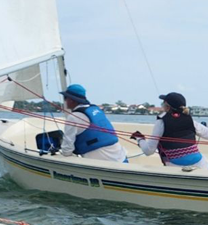Sailing Skills for Beginners

As a crew member on a small sailboat, you’ll primarily be responsible for handling the sails and lines. With a lesson or two from our professional instructors you’ll be mastering these basic skills in no time, then you’ll be well-prepared to crew and contribute to a safe and enjoyable sailing experience.
Sail Handling
Hoisting and lowering sails. This involves understanding the proper techniques, using halyards and sheets, and ensuring the sail is correctly raised or lowered.
Reefing and Furling. Knowing how to reduce the sail area in strong winds by reefing the mainsail or furling the jib.
Tacking and jibing. Understanding the steps involved in turning the boat upwind or downwind, and how to handle the sails during these transitions.
Line Handling
Cleating and unclipping. Securely fastening and releasing lines to cleats.
Line management. Keeping lines organized and tangle-free.
Tension control. Adjusting the tension of lines to control the sails and boat.
Safety
Knot tying. Understanding basic knots for securing lines and rigging.
First aid. Having basic first aid knowledge is always beneficial, especially on the water.
Emergency procedures. Being familiar with emergency procedures, such as man overboard drills.
Additional Skills
Navigation. A basic understanding of which way to go can be helpful. Here’s some useful pointers for Sarasota Bay.
Weather awareness. Being able to read weather patterns and make informed decisions about sailing conditions.
Physical fitness. Sailing can be physically demanding, so having a reasonable level of fitness is advantageous.

Want to explore lessons?